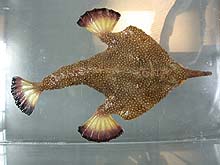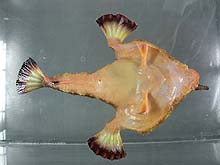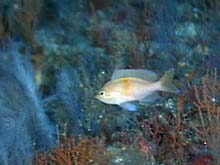
Roughtongue bass are a small member of the grouper family and are one of the two most common fishes encountered on these ledges. The ledge is covered with hard and soft corals, bryozoans, and various invertebrates. Click image for larger view.
The Fascinating Fishes of Cape Fear
September 26, 2001
Fred C. (Fritz) Rohde
Biologist Supervisor
North Carolina Division of Marine Fisheries
For the past 18 years, I have been investigating the North Carolina commercial fishery for reef fish, primarily snappers and groupers. While the snapper-grouper complex consists of about 75 species that are important to fishermen in the South Atlantic, most of their catch is dominated by 10-14 species. Occasionally, they would bring in some small, highly colorful fish for me to identify. I discovered that scientists considered many of these species rare in our area, while others were previously unknown off North Carolina, and sometimes, were new to the South Atlantic. When questioned as to where they were caught, the fishes often answered “The Steeples," which is an area off Cape Fear named for its high-profile hard bottom. For years, I have wondered what it would be like to actually dive on The Steeples and see firsthand the fishes that I have been studying for years. On September 26, I finally got the chance.
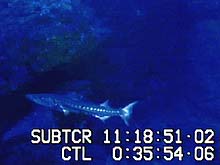
This barracuda was one of the first encountered on the submersible's final descent of the field season. Click image for larger view.
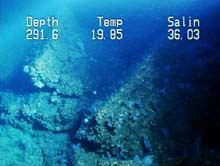
Several boulders lying on the sea floor were quite angular and rectangular, causing the scientists to muse about the Lost City of Atlantis. Click image for larger view.
'Awestruck'
I felt like a country kid who'd made his first trip to the big city. "Awestruck" sums it up best. I sat in my seat facing a steep limestone wall covered with hard and soft corals, sponges, and bryozoans. Clouds of small fishes, ranging in size from under 1 in to about 4 in, were everywhere. When the sub lights hit them, they were transformed from silvery gray streaks into beautiful pastels of red, pink, and yellow. Most abundant were roughtongue bass and red barbier, small species that belong to the same family as the large groupers. Cruising across the wall slightly above them were several small scamp grouper, an important commercial fish. A few small manta rays and their remora associates also glided over our sphere.
Attached to the submersible is a moveable arm and suction hose. We used this hose to “slurp up" a number of these small, colorful fishes so that we could determine what they were. This is not as easy as it sounds, and it took some time to get samplse. Then we did a transect along the face of the ledge about midway between the top and bottom. As we left the sandy bottom, rubble and boulders revealed where parts of the ledge had collapsed. Some of the rubble was so angular and rectangular in shape that the pilot joked that we had found the Lost City of Atlantis. This ledge was probably formed during low sea levels that occurred during the last Ice Age.
We found another suitable site for sample collecting, where we caught scorpionfish, bigeye, gobies, and some other small, still unidentified fishes. Even though it seemed that we had just started, time was rapidly running out. We continued on our transect until the ledge ended in about 250 ft of water. Notable in this stretch were schools of small vermilion snapper (or beeliners), which are the most commonly caught fish in the area. Also we saw three spanish flag, only a few specimens of which have ever been found off the North Carolina coast. While we waited for clearance to ascend, we sat the submersible on the sandy, soft coral-covered bottom above the ledge and observed many tropical fishes, including blue angelfish, damselfish, tattler, grunts, and others.
Some 4-1/2 hrs after descending, I gingerly extracted my cramped and aching body from the submersible. It was well worth it! I had just experienced one of the most memorable events in my life.
Sign up for the Ocean Explorer E-mail Update List.












































